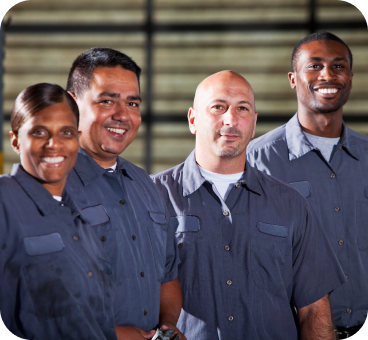Why Restoration Companies Are Replacing Paper SOPs With Digital Alternatives



The SOP binder was there. Technically.
Coffee-stained. Dog-eared. Wedged under a stack of customer receipts on the passenger seat.
It had the right steps...if you could find the right page. If you could remember to look through it. If you weren’t ankle-deep in Category 3 water with a distraught customer staring over your shoulder.
Across town, another restoration technician walked into a similar CAT-3 water loss job site. She tapped open a digital SOP on her phone, complete with annotated photos and step-by-step, carrier-approved processes. She’d only been with the company six months. But she moved like she’d been in the restoration industry for decades.
Similar jobsite. Same industry. Two completely different realities.
This isn’t a story about technology preferences. It’s about execution and what happens on the job when SOPs are buried in a binder versus built into your team's daily workflow.
And as restoration companies like Alpine Cleaning & Restoration are proving, that shift changes everything: job completion speed, consistency, and profit margins.
The Illusion of Having SOPs (and the Risk to Your Margins)
Most restoration companies do have SOPs. They just don’t use them.
They’re in the back office, tucked inside outdated folders, or sometimes stuck on shelves. Maybe your best tech helped write them, but that was two managers ago. And now?
You have the tenured tech who’s memorized most of the process and still swears by the three-ring binder. The new hire who instinctively reaches for their phone, but freezes when all they find is a PDF. And the in-betweeners, toggling between half-remembered instructions and half-loaded files, doing their best but missing details all the same.
It’s not a people problem. It’s a clarity problem. And it shows up everywhere: in costly delays, inconsistencies, and preventable rework that eats into already thinning profits. Not because no one knows what to do, but because there's no standardized way of doing things.
Where Paper SOPs Break Down, and Your Efficiency With It
Restoration isn’t a desk job. Decisions happen fast—on wet floors, inside crawl spaces, under pressure.
Paper SOPs can’t surface mid-job during water damage restoration. They can’t update to reflect the new IICRC guidelines. And they certainly can’t answer questions when the clock’s ticking, so your team guesses, stalls, or waits for someone to pick up the phone.
That compounds quickly into delayed jobs, increased callbacks, and teams operating at half-speed because they don’t have clarity.
The Real Cost of SOPs That Don’t Get Used
No one blames the dusty binder when the job goes sideways. But maybe they should.
Every missed step, every kicked-back scope, every new hire improvising containment—it all traces back to one thing: a process that wasn’t accessible when it mattered.
That cost doesn’t always show up strictly in dollar terms. It also shows up in poor customer reviews. In late nights spent fixing a mistake instead of building your business. And when your best tech leaves? So does everything they carried in their head, because you never got it out and into a system someone else could use.
That’s not just an operational problem. It’s a margin problem.
When SOPs Become Muscle Memory (And Rework Fades)
At Alpine Cleaning & Restoration, the SOP binder wasn’t just replaced; it was phased out by intentional organisational habits.
They started small, using a restoration-specific tool like KnowHow containing thousands of ready-to-use templates. One SOP, reviewed at the morning meeting. Everyone opened it on their phones. They walked through it together. Then they repeated the process the next day. And the next.
Eventually, it became part of their morning rhythm. Nothing complicated. Just deliberate repetition. Within a week or two, even new hires knew where to look, and when questions came up on the job site, they instinctively opened the KnowHow app they’d already used three times that week.
What’s the impact of reviewing an SOP just once? Sure, it might stick for a few days—small gain. But week after week? Now, you’re building mastery.
The result? Less rework. More autonomy. Fewer calls for clarification. And a workforce that moves faster without cutting corners.
Why Digital SOPs Improve Execution (and Job Closeout Speed)
Technicians don’t need more information. They need the right answer, at the right moment, in the right format.
Digital SOPs aren’t about tech for tech’s sake. They’re about meeting your team where the work is happening. Not on a laminated sheet. But on-site, in context, and with the clarity to move forward.
When SOPs live in your team’s hands—searchable, visual, updated—they stop being rules and start being resources. That’s when execution tightens. Job closeouts speed up. And team leaders stop fielding the same questions every week.
Start Where the Pain Is (And Protect Your Profits)
Pick the SOP that causes the most questions. The step that’s always skipped. The moment that costs you more time than it should.
Follow your best tech, capture what they do, turn it into a guide, make it visual, and then share it.
That’s exactly what Alpine did with KnowHow. They didn’t roll out 100 SOPs overnight. They started with one. Then they instilled a daily habit through KnowHow's functionalities like Workflows and Skill Builder.
The result? Faster ramp-up for new hires. Fewer mistakes. Higher job consistency across locations. And a culture where quality was a shared standard, not some theoretical ideal.
The Bottom Line: Less Rework, Faster Jobs, Better Margins
Your SOPs aren’t failing because your team doesn’t care. They’re failing because your team can’t use what they can’t see.
Digital SOPs, hosted on a platform like KnowHow, fix that. But the real unlock isn’t the format or how it's presented. It’s the habit your team members build. When your team knows where to look, what to do, and why it matters, they don’t wait for direction. They move.
That’s the shift Alpine made. Not all at once. But SOP by SOP, until the binder didn’t matter anymore, because the knowledge wasn’t hidden. It was living in everyone's head.
Execution shouldn’t depend on memory. Or luck. Or one person picking up the phone.
It should look like this: Open KnowHow. Follow the outlined steps for the process. Finish with glowing reviews from your customers.
That’s what standardization feels like, and it shows up where it counts: in your job closeout speed, reduced callbacks, and upward trending bottom line.
The restoration companies that thrive in the coming years won’t be those with solely the biggest fleets or the most technicians. They’ll be the ones that most effectively capture, standardize, and consistently execute their expertise. Book a time to see how KnowHow can help you become that type of forward-thinking restoration company.









